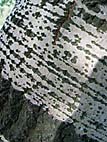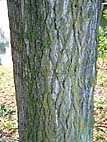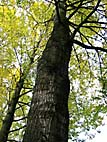Extra Bark page of Dutch hardwoods.
This bark page is just for fun and games. For the beautiful photo's. It is not really part of the winter bark-key or the elimination winter-key.
This page is photographic. I sum up a number of species in a class and then show all pics randomly (kindof not really). You can see by the Dutch names of the links to the full-size photo's "(eik)" what species it is. I use four classes:
1. Characteristic bark
2. Smooth bark
3. Coarse bark
4. Cracked bark or halfway between smooth and coarse
First the bark you also could have identified with the elimination winter key :
1. Characteristic bark
1. Characteristic bark | 2. Smooth bark | 3. Coarse bark | 4. Cracked bark or halfway between smooth and coarse | Back to the bud page
These are the species:
- Everyone knows the Birch with its white bark. (berk)
- River birch Betula nigra (berkzwarte)
-
The Poplar genus contains three species with strikingly grey /white bark:
European white poplar Populus alba (populierabeelwit) and Aspen Populus tremula (populierratel) and Grey poplar Populus canescens (populierabeelgrijs) - Species with bark where small pieces fall of are London planetree(Platanus hybrida ) and Oriental planetree. (platanushybrida)
-
A very coarse characteristic grey bark has
Black locust Robinia pseudoacacia. (acacia) - Similar is the Caucasian Wingnut Pterocarya fraxinifolia (vleugelnoot).
- De Sweet cherry Prunus avium, has characteristic shiny horizontal bands of bark. (prunus)




































































Smooth bark
1. Characteristic bark | 2. Smooth bark | 3. Coarse bark | 4. Cracked bark or halfway between smooth and coarse | Back to the bud page
There are not really many tree spieces that have smooth bark. These do:
- European Beech Fagus sylvatica (bark stays smooth even when bigger than 2 metres around. Although it gets some scars when it gets bigger. But never really coarse bark with grooves. (beuk)
- Common ash Fraxinus excelsior (until a meter around often smooth bark. After that it can get some ridges. Easily recognizable by its big black hoove-shaped buds. (es)
- Manna Ash, or Flowering Ash Fraxinus ornus (Haven't seen it more than 60 cm around so wouldn't know how it looks bigger than that. Has peculiar white spots on the bark, but I am not sure if that is common. (esonbekendpluim)
- Sycamore maple Acer pseudoplatanus can stay smooth uptil 60 cm around or more. It can also have little pieces of bark missing, which gives it a spotty look. Strikingly green buds and often bunches of stalks on the tree in the winter where the winged-fruit used to be attached. (esdoorn)
- Honeylocust Gleditsia triacanthos. Often has a coarse bark with strickingly light-brown bunches of thorns. Cultivars might lack the thorns and then they are less easy to identify. Have hidden buds. Often have long curly brown peas on the tree. On this page are photo's of cultivars that have no thorns and that are smooth in bark. (christusdoorn)
- Also here are a Linden (linde) and a Red Horse chestnut (paardenkastanjerood) that are pretty smooth.
- Horse chestnut Aesculus hippocastanum. Often has a twisted trunk and pieces of bark missing. Bark is often very ligh grey. Often trees and candle-shaped: thick branches that leave the trunk rather low and that are very round going form horizontal to vertical. Has big brown sticky buds. (paardenkastanje)
Tree species where individuals have smooth bark when small, but coarse bark later: Dutch Elm, Sweet Chestnut, Black alder, Sycamore Maple.








































2. Coarse bark schors
1. Characteristic bark | 2. Smooth bark | 3. Coarse bark | 4. Cracked bark or halfway between smooth and coarse | Back to the bud page
- English oak. Quercus robur (eik)
- Dutch Elm or Ulmus hollandica. Hard to recognize, best clue is the round buds. There is also a golden elm (iep@goudipe) amongst the trunks. (iep)
- Big Linden, more than 2 meters around. Lindengenus or Tilia (Tilaceae). See cracked bark cause this one could be listed under both. (linde) There is also a Silverlinden (Tilia tomentosa). (linde@zilverlinde))
- Sweet chestnut (small trees are very smooth in bark) Castanea sativa. Big trees, one meter and more get a coarse bark. The bark is beautifully lined vertically and somehow seems very distinguished to me. The lines are very symetric. When the bark is not really coarse yet, the vertical bark seems to have a wafle like pattern. (kastanjetam)
- Caucasian Wingnut Pterocarya fraxinifolia. Characteristic bark. Often a low large tree. "Strings" hanging form its branches in the winter. (vleugelnoot)
- All large willows have coarse bark. Willow genus or Salix (Salicaceae). Look ancient when they are big: they are not, they just grow fast. Not a beautiful crown: they rather look like a potato that has grown out shoots. Very coarse bark. (wilg)
- All poplars (except Aspen and White and Grey poplar). Poplar genus or Populus (Salicaceae). Poplars can be recognized by shiny whitish bark. Such bark is often seen high up the tree, and sometimes even from a few meters of the ground. Bark gets really coarse, like the willows (they are related) and the trees get very high. Often lots of twigs on the ground, since they break easily. The twigs are not smooth wood at all, not stiff, and with rough patches. Mostly planted in parks, along roads and besides polders. (populier)
- Southern catalpa Catalpa bignonioides. Often still grey peas on the branches. Has no visible buds. Bark looks like the English oak. (trompetboom)
- Japanese scholar tree Saphora japonica. Bark is something in between the English oak and the Black locust.(pagodeboom)
- Katsura tree or Cercidiphyllum japonicum (onbekend1hartblad)
- Also listed is the Italian Maple or Acer opalus. (esdoornonbekend)
Cracked bark or halfway between smooth and coarse
1. Characteristic bark | 2. Smooth bark | 3. Coarse bark | 4. Cracked bark or halfway between smooth and coarse | Back to the bud page- Red oak Quercus rubra. Characteristic vertical cracks in the greyish rather smooth bark. The cracks are light in color so it seems something is appearing from under the bark. Often horizontal ring-like bands on the branches and trunk.(eik@eikamerikaanse)
- Common alder; European alder; Black alder. Small trees have a very smooth green bark with yellowish stripes/dots. Black alder Alnus glutinosa. Bigger its bark gets blackish with cracks horizontal and vertical. Buds are grey and a bit bend or clam-shaped. Very common tree in the Netherlands in the forests. Often near water.
- European hornbeam; Musclewood; Ironwood Carpinus betulus. Some are really smooth. Sometimes the trunk has a twist and sometimes it seems you see bundles of "muscles" under the bark. Buds like the European beeck, but not on stalks. (beuk)
- Norway maple Acer platanoides, is somewhat smooth, with some cracks and fine ridges when you look really close. The ridges get a bit more large when it gets bigger, but not much. Beautiful red buds.(esdoorn@esdoornnoorse)
- Italian Alder Alnus cordata (els@elsgrauwe)
- Turkish Filbert Corylus colurna ()onbekend@elsig)
De namen van de foto's hier zijn verwarrend, omdat er eerst fouten in zaten zijn sommige dingen niet voor zichzelf sprekend:
beuk@onbekend=haagbeuk
elsig=boomhazelaar
onbekendhartblad=katsuraboom
.
elsgrauwe=Hartbladige els.














































































































